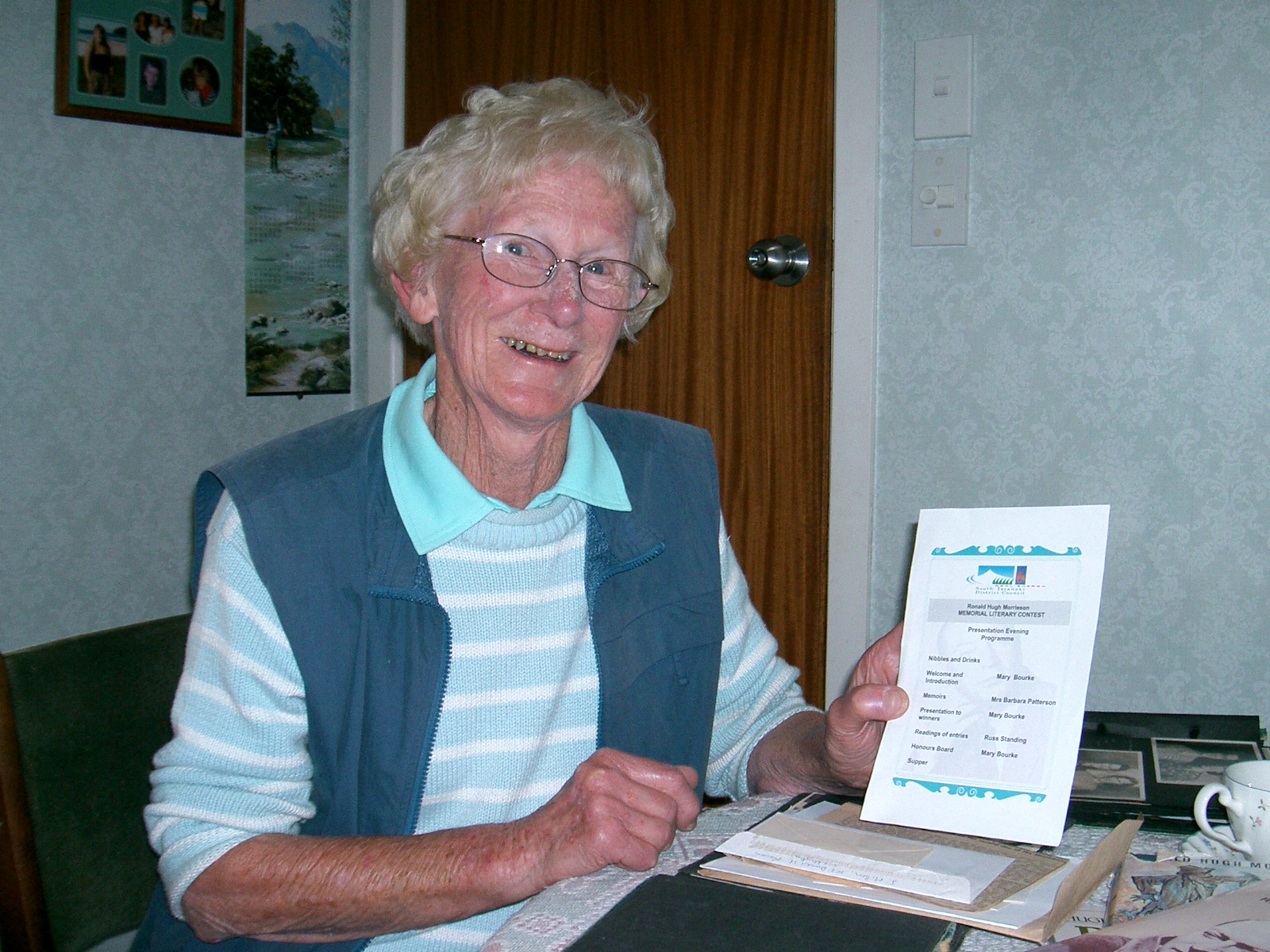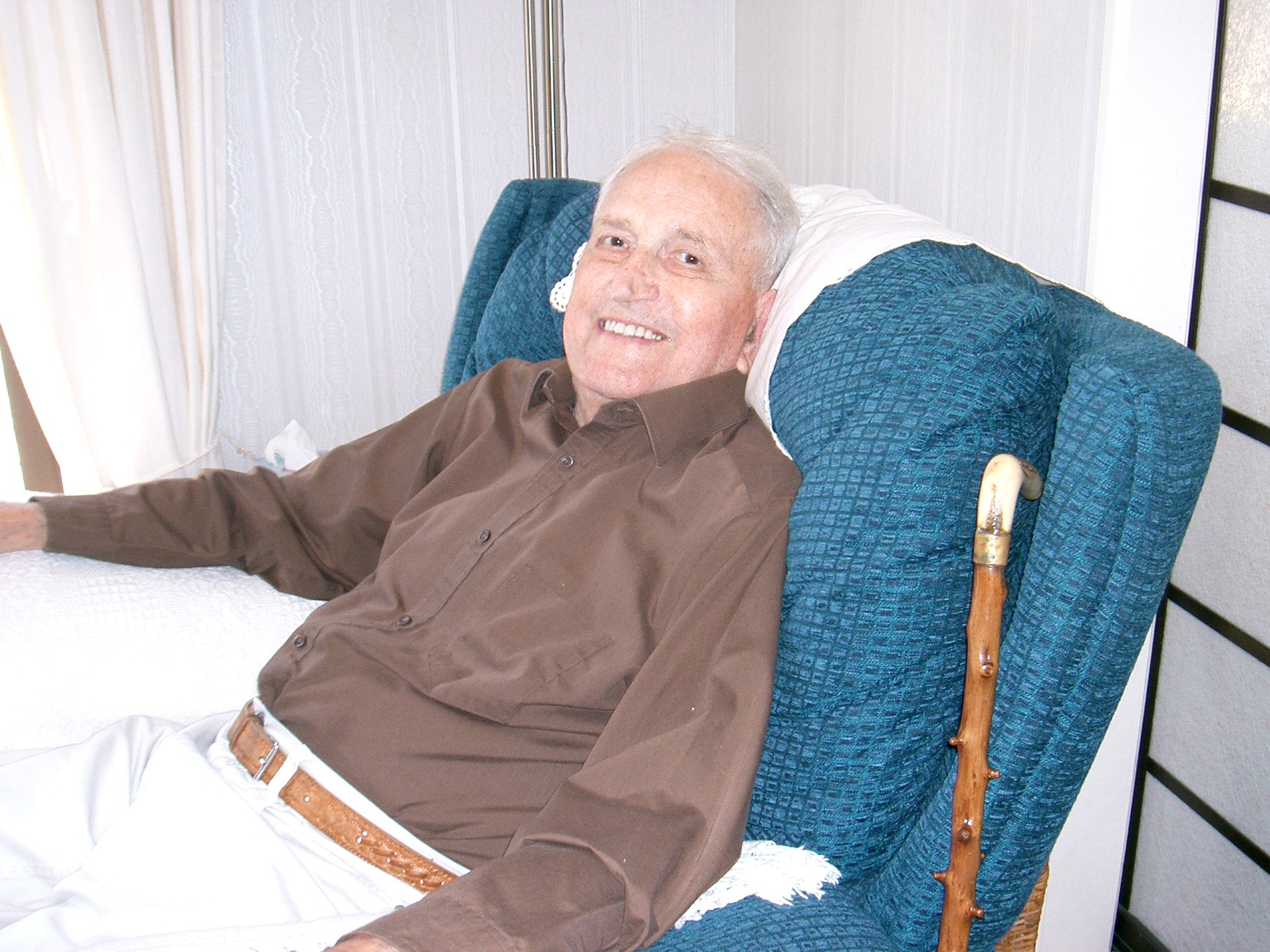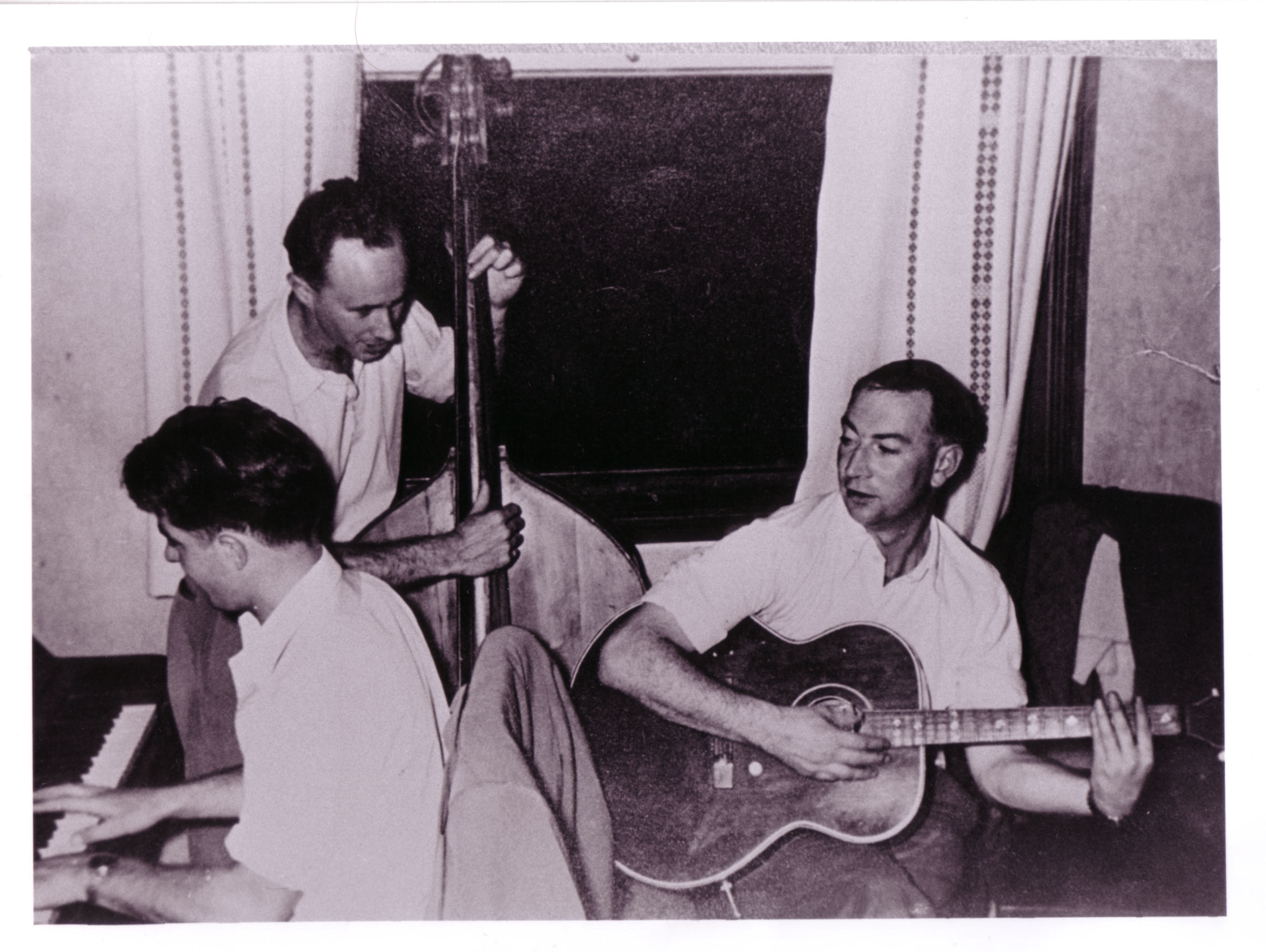





Malcolm Robinson and Ronald Morrieson grew up pretty much joined at the hip. Two parts of the Terrible Four along with Gerald Patterson and Len Flavell, Robinson describes his mate Morrieson as a chameleon, “a total charmer”.
“We were an average group of 12 to 14 year-olds having tons of fun on our bicycles” he says of their teenage years. “Morrieson's most valued possession was a Rudd Whitworth, the crème de la crème of bikes. We used to ride all over the place but we never did anything nasty. We never broke letterboxes or anything like that. It was only later in life we got in trouble with the cops.”
Robinson, a retired Opunake accountant living in New Plymouth when interviewed in 2005, says Morrieson was often in strife at school because of his penchant for pranks. His infamous batch of potent parsnip wine was quite an achievement for a ten year-old, though it launched Morrieson's drinking career. “I drank a lot at his place” Robinson grins. “But not what he made. Ron used to organise the beer from the local brewery in sugar sacks that held 4 dozen big bottles of beer. OC [Octopus Clamp] was one and VC [Victoria Cross] was the other made at the Hāwera Brewery. Octopus Clamp came from a hold used by wrestler Lofty Bloomfield, a hero of Ron's.”
Along with a talent for music, Morrieson honed his amateur wrestling skills. Robinson remembers a night many years down the track when Morrieson treated his old mates to a social demonstration. “My God! What a bloody performance. He got this school teacher and gave him 'an aerial helicopter.' Lifted him up, swung him round and round and threw him down on the floor, then lifted him up on his knees and dumped him. Poor fellow, he drank a bottle of brandy that night, and the next day drove the school bus, and he had to keep stopping to have a throw-up.”
He says Morrieson was seriously into billiards and snooker and even though playing for money was illegal, he suspects his friend made “quite a lot” off his cue. “We used to play a lot, Ron and I. He was far better than I because he didn't work. He didn't ever have a job. He spent yonks up in that pool room.”
Robinson can tell some wicked stories. There's the time Morrieson drove his car along the main trunk line for a dare. How he could handle himself in a fight. The nights spent boozing and counting the Count Basie beat, with a heavy bass going boom, boom, boom.
He speaks candidly about the time when the car Morrieson was driving hit a Stratford girl. Ron was 18 at the time while his mates were mostly younger. “We had hidden the beer somewhere, so he came and picked us up, and we took it up a side road where we could drink it in peace. We cleaned up what we could clean up. We had a big car, so there was the driver and two guys in the front and four of us in the back. Stratford had tar seal on one side of the road, and a dirt strip on the other. The lights failed, so we decided we would go carefully down the dirt part.
“Somebody said, 'God, you've hit somebody!' Those in the back saw nothing. Those in the front didn't see much. We had no headlights. When we got home we saw a headlight was all tipped up. The next morning, Ron gets in touch with me. 'God, it's in the paper! Unlighted touring car hits girl, carries her 70ft'.” The boys decided to turn themselves in. “We were busy manufacturing alibis but, of course, the cops got us one at a time. They left me till last, being the youngest, and then they told me the others had confessed. And they had the story pretty much right, and they scared me, so I told the truth and we were all in the gun.”
When Truth got hold of the story, new headlines screamed: “Boy, 16, has standing account at brewery”. “I didn't have a standing account,' Robinson says. “We certainly had a standing account. Friday we picked up the beer. Saturday, we passed the hat and paid for it.” Morrieson was given a curfew that curtailed his movements for two years, though he still “snuck out whenever it suited him”.
Morrieson loved to play cat and mouse with the law, sometimes with the help of his mother. “One night we were at the Rewa Tearooms. Morrieson turned up about half past eleven. We hustled him down the back stairs just as the cops came up the front stairs. The cops thought they had him, but he went down a side alley and beat them home. He just got into the house, and they knew he was there, they'd seen him. Mrs Morrieson opened the door.
'Is Ron home, Mrs Morrieson?'
'Of course Ron's home. He's not allowed out.'
'We saw him in the street.'
'No, you must be mistaken.’''
Later Morrieson entertained his friends by demonstrating how he stood behind the door, listening to the constable's heavy breathing.
Barbara Patterson, whose husband Gerald had known Morrieson since kindergarten and was one of the Terrible Four, said they spent many nights partying at the Morrieson home, but saw little of Ron's mother. “I'd been in that house numerous times and never seen Mrs Morrieson. There'd be Gerald, myself, another couple, Derek and Maureen, and Joyce used to be with us too and we'd go back there after a dance.
“We'd be in the music room and there'd be a discreet knock at the door and Ron would go to the door and he'd go out into the hall and you'd hear this quiet talking, and then he'd come back in and close the door, and we'd just go on as though there'd been no interruptions. And then a bit later, there'd be another knock and he'd go to the door and come back with tea and toast for us all.
“The only part of the house I ever saw was that room, the front hall, until the book was published and Gerald and I were out in the kitchen and his mum and auntie were sitting at the table with a few other people. One of them was one my husband reckoned was one of the characters in The Scarecrow. Don't ask me to name names.”
Malcolm Robinson describes Eunice Morrieson as a “most unusual person. Such a reclusive person”. A hello might get a hello back, but that was all. His memories align with Barbara Patterson's. “We'd go down to Morrison's. Mother would let us in. She would open the door and say 'Ron's upstairs', and we'd go upstairs into this attic place and get on with serious drinking. She wouldn't stick her nose in. She'd tap on the door about half past ten and there'd be mum with a plate of scones and cups of tea. The fact is, we'd be busy getting blotto and we did this every Friday night.”
They easily recall the 1940s as a great social era. While other people headed home to sleep, Morrieson and his mates would head out to a dance. With a hip flask in one pocket and smokes in another, Morrieson's band would play at Hāwera, Kakaramea, Normanby, Te Roti, Tokaora or Manaia.
Barbara Patterson, too, has a repertoire of typical Morrieson stories including one that began after a 21st party. “We got in the car and went down High Street, which slopes down, and I don't know how we got talking about the undertaker, Davey McCormick, but Ron said, 'This is what Davey McCormick does at a funeral,' and he hopped out of the car, walked in front , and here was the driverless car coming along behind him. And when we got to the flat part, got back into the car and we went round to the cemetery.”
At the cemetery, she, Gerald, Ron and Joyce sat on tombstones and discussed Shakespeare, and who might have written the stories in his name. Eventually they left. “Anyway, the car ran out of water. The boys went hunting for a tap somewhere and couldn't find any, so they came back and peed in the tank. Then Ron said to Joyce she should pee in the tank too!”
Despite wearing a gorgeous diamond-pin-tucked organza dress, Joyce obliged, after Ron, ever the gentleman, put his coat over the windscreen “to stop anyone seeing”. “He could sweet talk her into anything,' Patterson says. 'He had Joyce sitting up there and along came a car, and it was Malcolm and Moorie who were getting married next day. They'd been down to Wanganui to pick up their best man. All the talking and laughing that went on outside that car…!”
Out of the group, only Ron was not married but his eye for a skirt was legendary. Patterson says, “Gerry, Malcolm and Len all got married in the same year, between August and mid-September. Joyce was in love with Morrieson, but I don't think her father would have ever let her marry Ron, even if Ron was the marrying kind, which he wasn't. As someone once said, Ron was in love with his mother.
“There were men, probably still are men, who are not the marrying kind. I mean, my brother didn't marry and he was a man's man, there was nothing funny about my brother. There were a lot of men like that.”
Robinson agrees. “Marriage was never going to happen. Joyce was in love with him, all right. But it would have been a tragedy. She would have tried to reform him. Every good woman sees some good in a man, but he was far beyond redemption at that stage.”
Georgina was a different kettle of fish. “Whatever Georgina was, she was his drinking buddy,” Patterson says. A beautiful woman who dressed like a queen, 'Georgie' drew men like 'bees round a honey pot'.
“He was as oversexed as they come,” Robinson smiles. “Any girl who was willing, he'd oblige. He had the field to himself (during the war). He was the only fit man in Hāwera. He enjoyed his lifestyle tremendously, I think.”
Morrieson wrote four novels: The Scarecrow, Came a Hot Friday, Predicament and Pallet on the Floor. Patterson remembers well the day his first came out. “We went down to the house to congratulate him. There was his mum and aunt and some very close friends, just a little family get-together. He was going to have an official party, but that's when my husband went missing, and that put the kibosh on any plans Ron had. It absolutely shattered Ron.”
Tragically, Gerald Patterson, who had survived the war at Monte Cassino, drowned while fishing from a beach south of Hāwera. “Ron was in tears for a week and he didn't come and see me at all, not for a week or two, he was just too upset. I don't think he ever got over it” Patterson says. “Just as he never got over losing his mother.”
Morrieson was “never any good after his mother died”, and it was the only time his friend became impatient with him. “I ran into him in the butcher's shop and he looked dreadful. He was definitely a down and out alcoholic by then. I asked him how he was and he said, 'Well, you know how it is, Barbara, you've been through it.' But it was not the same. My husband was a young man, taken in the prime of life, and his mother was an elderly, sick lady.”
She says after Morrieson's death in 1972, a raft of media arrived in Hāwera, intent at making him into a deviant he was not. “All they wanted was muck. They twisted things that people said and had others dancing on his grave. Well, that was just a load of rubbish. It was a total load of rot.”
Friends were sickened by suggestions that the writer had a predilection for under-aged girls. “I know how fond he was of women. I know that's where his natural instincts were. He didn't have any interest towards anything else.”
Patterson says, despite his reputation, Morrieson was a highly moral person. “All the times I knew him, up until the day he died, I never heard him swear in front of a woman, or tell a dirty story in front of a woman, and you can't say that about a lot of other so called upstanding Hāwera citizens.”
“No,” Robinson laughs. “I thought they were utterly corny at first. I've read them several times since and like his sense of humour. Those books were good. I had them all. The movies were bloody good.”
While Patterson is proud of his writing, she has no idea what his mother thought of it. “Aunty Doris did the typing so she knew what they were about, but as Ron said to us, 'She typed them but I didn't let her type the masturbation scene'.”
Even after 30 years, their affection for the writer is plain to see. “He was a brilliant story-teller, a raconteur, and he was always welcome in our house.”
Millen, J. (1996). Ronald Hugh Morrieson: A Biography. Auckland: David Ling.
Morrieson, R. H. (1964). Came a Hot Friday. Sydney: Angus & Robertson Ltd.
Morrieson, R. H. (1976). Pallet on the Floor. Palmerston North: Dunmore Press.
Morrieson, R. H. (1981). Predicament. Palmerston North: Dunmore Press.
Morrieson, R. H. (1963). The Scarecrow. Sydney: Angus & Robertson Ltd.
Puke Ariki Heritage Collection: Ronald Hugh Morrison
LinkPlease do not reproduce these images without permission from Puke Ariki.
Contact us for more information or you can order images online here.